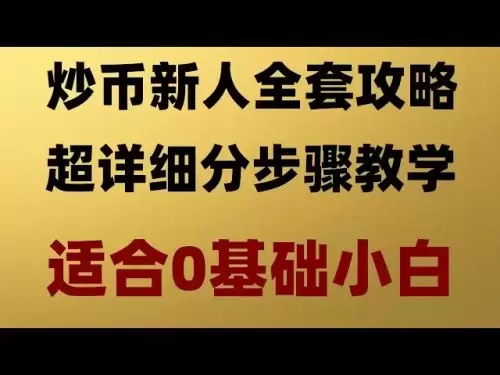-
 Bitcoin
Bitcoin $106,211.1658
0.62% -
 Ethereum
Ethereum $2,572.0517
1.54% -
 Tether USDt
Tether USDt $1.0002
-0.03% -
 XRP
XRP $2.1830
1.20% -
 BNB
BNB $652.5726
0.56% -
 Solana
Solana $156.6468
7.35% -
 USDC
USDC $0.9999
0.00% -
 Dogecoin
Dogecoin $0.1770
-0.56% -
 TRON
TRON $0.2715
0.13% -
 Cardano
Cardano $0.6403
1.72% -
 Hyperliquid
Hyperliquid $42.5647
6.09% -
 Sui
Sui $3.0838
2.97% -
 Bitcoin Cash
Bitcoin Cash $457.5387
4.49% -
 Chainlink
Chainlink $13.4460
1.39% -
 UNUS SED LEO
UNUS SED LEO $9.2625
0.15% -
 Avalanche
Avalanche $19.4071
1.98% -
 Stellar
Stellar $0.2606
0.98% -
 Toncoin
Toncoin $3.0013
1.10% -
 Shiba Inu
Shiba Inu $0.0...01214
0.29% -
 Hedera
Hedera $0.1564
1.48% -
 Litecoin
Litecoin $86.9375
1.08% -
 Polkadot
Polkadot $3.8613
1.79% -
 Ethena USDe
Ethena USDe $0.9998
-0.06% -
 Monero
Monero $316.5122
0.32% -
 Dai
Dai $0.9999
-0.01% -
 Bitget Token
Bitget Token $4.5634
0.87% -
 Pepe
Pepe $0.0...01129
1.55% -
 Uniswap
Uniswap $7.4180
1.07% -
 Pi
Pi $0.6028
-2.22% -
 Aave
Aave $279.1694
1.03%
What does it mean when the VR indicator breaks through 400? Is the market overheated?
When the VR indicator exceeds 400 in crypto trading, it signals intense buying pressure, but traders should assess context, market conditions, and supporting metrics before making decisions.
Jun 14, 2025 at 05:42 pm
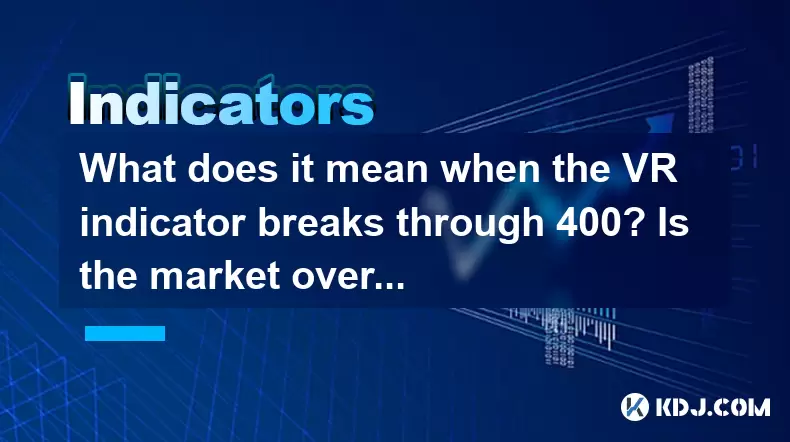
Understanding the VR Indicator in Cryptocurrency Trading
The VR (Volume Ratio) indicator is a technical analysis tool commonly used in cryptocurrency trading to assess the relationship between volume on up days versus down days. It helps traders gauge market sentiment by analyzing buying and selling pressure over time. The VR value is calculated using the formula: VR = (Sum of Volume on Up Days) / (Sum of Volume on Down Days). A rising VR indicates stronger buying pressure, while a declining VR suggests increased selling.
In the context of cryptocurrency markets, where volatility is high and trends can reverse quickly, the VR indicator becomes an essential metric for identifying potential turning points. Traders often rely on it to confirm price movements or detect divergences that may signal upcoming shifts in momentum.
Key Takeaway: The VR indicator provides insights into volume-based market sentiment, helping traders understand whether accumulation or distribution is occurring.
What Happens When the VR Indicator Breaks Through 400?
A VR reading above 400 is considered unusually high and typically signals extreme bullish sentiment. This level suggests that the volume associated with up days significantly outweighs the volume from down days over the selected period. In many cases, such a surge occurs during strong upward price moves fueled by aggressive buying activity.
When the VR breaks through 400, especially after a sustained rally, it may indicate that the asset is entering overbought territory based on volume dynamics. However, unlike traditional oscillators like RSI, the VR does not have fixed overbought or oversold levels. Instead, its interpretation depends heavily on historical context and the specific behavior of the asset being analyzed.
- Historical comparisons are crucial when interpreting a VR above 400.
- Sudden spikes might reflect panic buying or short-term hype rather than sustainable demand.
- Extended periods above 400 could suggest a powerful uptrend supported by consistent volume growth.
Important Note: A VR above 400 should not be treated as a sell signal by default; instead, it should be evaluated alongside other indicators and price action.
Is the Market Overheated When VR Exceeds 400?
Determining whether the market is overheated requires more than just looking at a single indicator. While a VR exceeding 400 may suggest strong buying pressure, overheating usually involves additional factors such as:
- Extreme price acceleration without corresponding fundamental developments.
- High leverage usage across exchanges, increasing liquidation risks.
- Widespread retail participation driven by social media hype or fear of missing out (FOMO).
If these conditions accompany a high VR reading, there's a higher probability that the market is indeed overheated. However, if institutional inflows, positive news cycles, or network adoption metrics support the rally, the elevated VR might reflect healthy demand rather than speculative excess.
Critical Insight: An overheated market isn't solely defined by VR levels but by a confluence of volume, price action, sentiment, and macro factors.
How to Interpret High VR Readings in Different Market Conditions
Interpreting the VR indicator effectively requires tailoring your analysis to the current market environment. Below are key scenarios where a VR reading above 400 can offer different implications:
- In a bull market: A VR above 400 may indicate continued strength and confidence among buyers. If this occurs early in a rally, it can be a sign of strong accumulation.
- In a sideways or consolidation phase: A sudden jump in VR may precede a breakout. Watch for increased volume accompanying price movement beyond key resistance levels.
- Near all-time highs: VR surging past 400 here could reflect euphoria, but also warrants caution if no new fundamental catalysts exist.
Additionally, comparing the VR with moving averages or trendlines can help identify divergences. For example, if prices are rising but the VR starts declining from its peak, it may indicate weakening volume support behind the rally.
Practical Tip: Use VR in combination with on-chain metrics, funding rates, and order book depth for a more holistic view of market conditions.
Common Mistakes When Using the VR Indicator
Despite its usefulness, traders often make errors when incorporating the VR into their strategies. Some common pitfalls include:
- Misinterpreting absolute thresholds: There’s no universal "sell" or "buy" level for VR. What constitutes an extreme reading varies across assets and timeframes.
- Ignoring time frames: Short-term spikes in VR may not be meaningful unless they persist across multiple sessions. Always check how long the VR has remained elevated.
- Failing to combine with other tools: Relying solely on VR can lead to false signals. Pair it with price patterns, candlestick formations, or sentiment indicators for confirmation.
Another mistake is assuming that high VR always equates to overbought conditions. In strong uptrends, VR can remain elevated for extended periods without a significant pullback.
Caution: Avoid making trade decisions based solely on VR readings. Context and confluence matter more than isolated data points.
Frequently Asked Questions (FAQ)
Can VR be used effectively on lower timeframes like 15-minute or 1-hour charts?
Yes, the VR indicator can be applied to lower timeframes, but it tends to produce more noise due to rapid volume fluctuations. On shorter intervals, it’s better suited for confirming intraday momentum rather than predicting major trend reversals.
How does VR compare to other volume-based indicators like OBV?
While both VR and On-Balance Volume (OBV) track volume flow, VR focuses on the ratio between up and down volume, whereas OBV accumulates volume on up days and subtracts it on down days. Each offers unique insights depending on the trader’s objective.
Is there a standard period used to calculate VR?
Most platforms default to a 14-period calculation, similar to RSI, but users can adjust this based on their strategy. Longer periods smooth out the VR line and reduce false signals, while shorter periods increase sensitivity.
Can VR be misleading during pump-and-dump scenarios?
Absolutely. During artificial price manipulation events like pumps, volume surges rapidly and then collapses. This can cause the VR to spike dramatically before crashing, giving a false impression of sustained strength.
Disclaimer:info@kdj.com
The information provided is not trading advice. kdj.com does not assume any responsibility for any investments made based on the information provided in this article. Cryptocurrencies are highly volatile and it is highly recommended that you invest with caution after thorough research!
If you believe that the content used on this website infringes your copyright, please contact us immediately (info@kdj.com) and we will delete it promptly.
- Nexchain Isn’t Just Another Layer-1 Blockchain. It’s Made for the Future
- 2025-06-16 12:00:29
- We're on the final countdown to the 2025 Met Gala (it's next week, folks)
- 2025-06-16 12:00:29
- Cardano (ADA) Price Prediction: Will the Golden Cross Pattern Spark a Rally to New All-Time Highs?
- 2025-06-16 11:55:12
- BONK (BONK) Skyrockets by 67% as the Broader Cryptocurrency Market Recovers
- 2025-06-16 11:55:12
- XRP (XRP) Price Holds Above Critical Support Levels Despite Mixed Signals from Technical Indicators
- 2025-06-16 11:50:13
- Don't Miss These Top New Meme Coins to Invest in for Long-Term ROI
- 2025-06-16 11:50:13
Related knowledge

What does it mean when the trading volume is enlarged but the K-line body is very small?
Jun 16,2025 at 11:42am
Understanding the Basics of K-line and Trading VolumeIn cryptocurrency trading, K-line charts, also known as candlestick charts, are essential tools for analyzing price movements. Each K-line represents a specific time period and shows four key data points: open, high, low, and close. The body of the K-line reflects the difference between the opening an...
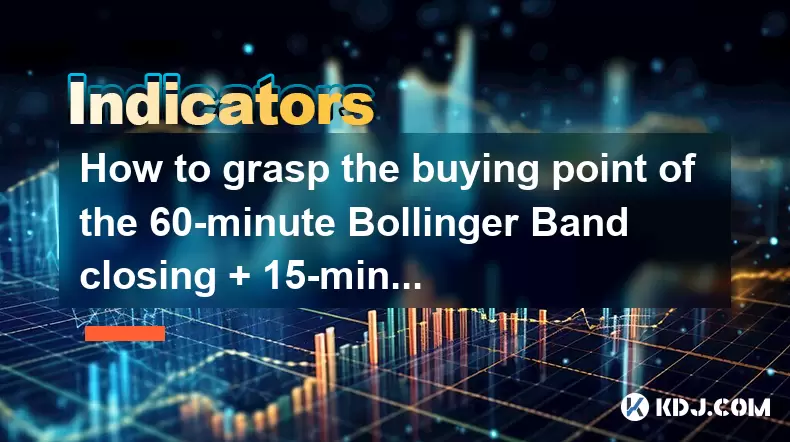
How to grasp the buying point of the 60-minute Bollinger Band closing + 15-minute MACD bottom divergence?
Jun 16,2025 at 12:03am
Understanding the Bollinger Band Closing Signal on a 60-Minute ChartThe Bollinger Band closing signal refers to a situation where the price closes outside the upper or lower band and then re-enters it in the subsequent candlestick. In this context, we focus on the lower Bollinger Band closing, which indicates a potential reversal from a downtrend. On th...
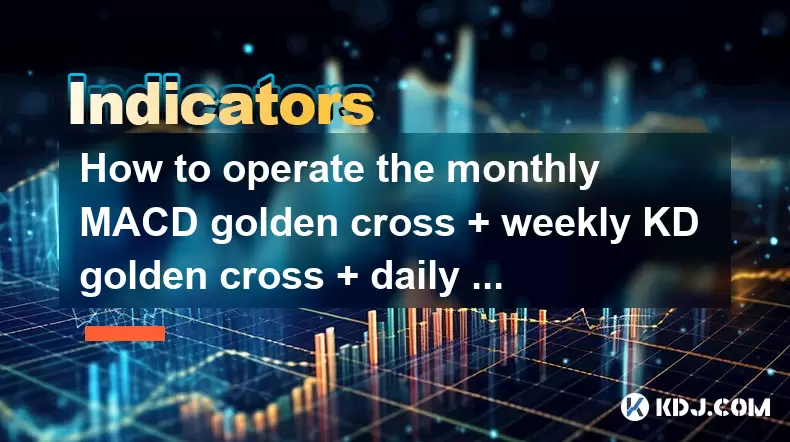
How to operate the monthly MACD golden cross + weekly KD golden cross + daily volume breakthrough?
Jun 15,2025 at 05:36am
Understanding the Strategy: Monthly MACD Golden CrossTo effectively operate the monthly MACD golden cross, traders must first understand what this signal entails. The MACD (Moving Average Convergence Divergence) golden cross occurs when the MACD line crosses above the signal line on a given chart timeframe. When this happens on the monthly chart, it sug...
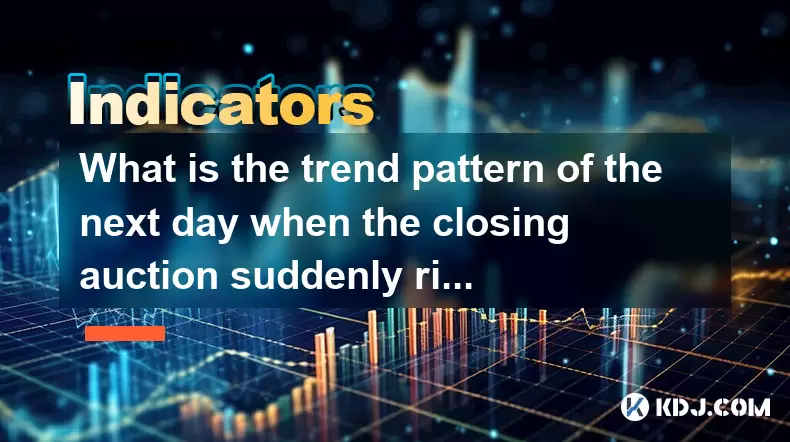
What is the trend pattern of the next day when the closing auction suddenly rises?
Jun 15,2025 at 08:15am
Understanding Closing Auctions in Cryptocurrency MarketsIn the context of cryptocurrency trading, a closing auction refers to a mechanism used by exchanges to determine the closing price of an asset at the end of a trading session. This process typically occurs within a short time window before the market closes for the day and aims to provide a fair an...

What does it mean when the volume fluctuates during the sideways trading at high levels?
Jun 15,2025 at 10:28am
Understanding Volume Fluctuations in Sideways TradingWhen volume fluctuates during sideways trading at high levels, it refers to the changes in the number of assets traded over a given period while the price remains relatively stable, moving within a defined range. This phenomenon typically occurs when the market lacks a clear directional bias—neither b...
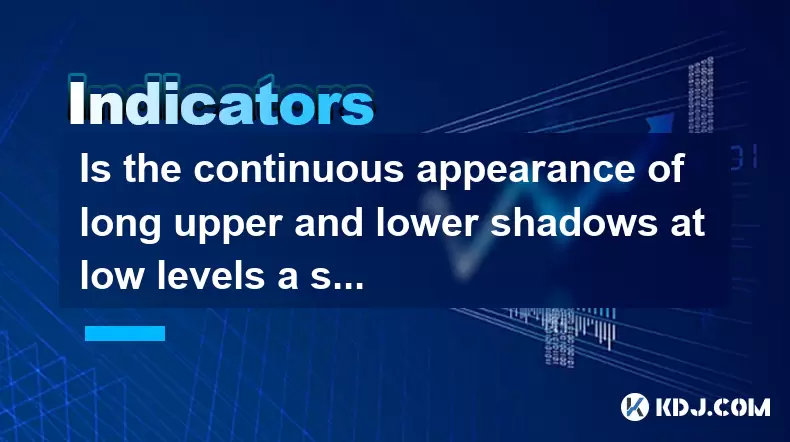
Is the continuous appearance of long upper and lower shadows at low levels a signal of accumulation?
Jun 15,2025 at 01:43am
Understanding Long Upper and Lower Shadows in Candlestick ChartsIn the world of cryptocurrency trading, candlestick patterns are widely used to analyze price movements. A long upper shadow, also known as a wick or tail, indicates that the price rose significantly during the period but was pushed back down by selling pressure. Conversely, a long lower sh...

What does it mean when the trading volume is enlarged but the K-line body is very small?
Jun 16,2025 at 11:42am
Understanding the Basics of K-line and Trading VolumeIn cryptocurrency trading, K-line charts, also known as candlestick charts, are essential tools for analyzing price movements. Each K-line represents a specific time period and shows four key data points: open, high, low, and close. The body of the K-line reflects the difference between the opening an...

How to grasp the buying point of the 60-minute Bollinger Band closing + 15-minute MACD bottom divergence?
Jun 16,2025 at 12:03am
Understanding the Bollinger Band Closing Signal on a 60-Minute ChartThe Bollinger Band closing signal refers to a situation where the price closes outside the upper or lower band and then re-enters it in the subsequent candlestick. In this context, we focus on the lower Bollinger Band closing, which indicates a potential reversal from a downtrend. On th...

How to operate the monthly MACD golden cross + weekly KD golden cross + daily volume breakthrough?
Jun 15,2025 at 05:36am
Understanding the Strategy: Monthly MACD Golden CrossTo effectively operate the monthly MACD golden cross, traders must first understand what this signal entails. The MACD (Moving Average Convergence Divergence) golden cross occurs when the MACD line crosses above the signal line on a given chart timeframe. When this happens on the monthly chart, it sug...

What is the trend pattern of the next day when the closing auction suddenly rises?
Jun 15,2025 at 08:15am
Understanding Closing Auctions in Cryptocurrency MarketsIn the context of cryptocurrency trading, a closing auction refers to a mechanism used by exchanges to determine the closing price of an asset at the end of a trading session. This process typically occurs within a short time window before the market closes for the day and aims to provide a fair an...

What does it mean when the volume fluctuates during the sideways trading at high levels?
Jun 15,2025 at 10:28am
Understanding Volume Fluctuations in Sideways TradingWhen volume fluctuates during sideways trading at high levels, it refers to the changes in the number of assets traded over a given period while the price remains relatively stable, moving within a defined range. This phenomenon typically occurs when the market lacks a clear directional bias—neither b...

Is the continuous appearance of long upper and lower shadows at low levels a signal of accumulation?
Jun 15,2025 at 01:43am
Understanding Long Upper and Lower Shadows in Candlestick ChartsIn the world of cryptocurrency trading, candlestick patterns are widely used to analyze price movements. A long upper shadow, also known as a wick or tail, indicates that the price rose significantly during the period but was pushed back down by selling pressure. Conversely, a long lower sh...
See all articles





















